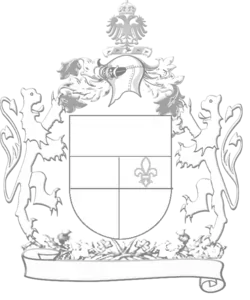Trophy of arms
A trophy or trophy of arms in art and architecture is a real or depicted artistically assembled display of weaponry and other militaria, often captured from a defeated enemy, as an ornament designed for the purpose of triumphalist display by a victor or as a show of military prowess by a monarch.[1] Similar decorative vertical arrangements of hunting accessories, musical instruments or other objects are also commonly referred to as trophies.

The term comes from the ancient Greek tropaion and Roman equivalent tropaeum, military victories which were commemorated with a display of actual captured arms, armour and standards. The use of trophies as an ornament in decoration became popular in the Italian Renaissance, and as an architectural element in relief or free-standing sculpture during the Baroque era, where they are often used as a kind of finial to decorate rooflines, gate columns and other elements of buildings with military associations, which included most royal palaces.
The Triumphs of Caesar by Andrea Mantegna (1482–94, now Royal Collection) are a series of paintings of the Roman triumph of Julius Caesar that soon became enormously influential in print form. They showed trophies carried on carts and on poles, and probably gave a big impetus to the trend for ornament prints of trophies, which were then copied into a range of media.
Origins
The practice was used in the classical age by the Greeks and Romans. Homer's Iliad relates the practice of warriors in the Trojan War removing the armour and weapons of a killed opponent in order to make an offering to the gods. This was contrasted to mere booty. Trophies of arms were commonly depicted on Greek and Roman coins.
In England a tradition of making trophies of arms and armour, designed to display British military prowess, was established in the armoury of the Tower of London from the late 17th century.[2] In about 1700, John Harris created an impressive display in the Grand Storehouse which included a serpent and a seven-headed Hydra, together with a variety of weapons including muskets, pistols and swords. The antiquarian William Maitland described it as a sight "no one ever beheld without astonishment...not to be matched perhaps in the world".[2]
Constituent elements
Elements commonly depicted within antique trophies of arms include:
- breastplates
- spears
- halberds
- bows
- arrows
- quivers
- lit torches
- swords
- cannon and balls
- captured military standards
- clubs
- heraldry and coats of arms
Gallery
 Antique trophy of arms, with Scottish bagpipes, engraving circa 1750 by William Hogarth (1697–1764)
Antique trophy of arms, with Scottish bagpipes, engraving circa 1750 by William Hogarth (1697–1764) Scene from the Triumphs of Caesar by Andrea Mantegna
Scene from the Triumphs of Caesar by Andrea Mantegna Roman Denarius circa 46-45 BC, depicting a trophy of arms tropaion from the Gallic Wars of Julius Caesar showing a captured Gaul on one side and a mourning female symbolizing Gallia, defeated, on the other
Roman Denarius circa 46-45 BC, depicting a trophy of arms tropaion from the Gallic Wars of Julius Caesar showing a captured Gaul on one side and a mourning female symbolizing Gallia, defeated, on the other Trophy in the 1st courtyard of Prague Castle
Trophy in the 1st courtyard of Prague Castle Trophy at the gate of the General Staff Building (Saint Petersburg)
Trophy at the gate of the General Staff Building (Saint Petersburg) Trophy at the main gate of Hampton Court Palace
Trophy at the main gate of Hampton Court Palace.jpg.webp) Trophies of arms with real weapons and armour at Peleş Castle, Romania
Trophies of arms with real weapons and armour at Peleş Castle, Romania The Coat of arms of Copenhagen doubles as a trophy of arms
The Coat of arms of Copenhagen doubles as a trophy of arms
See also
References
- Osborne, Harold, The Oxford Companion to Art, Oxford, Clarendon Press, 1990, p. 1161-2
- "Dragon | Royal Armouries". Archived from the original on 2015-08-01. Retrieved 2014-09-30.
External links
 Media related to Trophy of arms (antique) at Wikimedia Commons
Media related to Trophy of arms (antique) at Wikimedia Commons Media related to Trophy (architectural) at Wikimedia Commons
Media related to Trophy (architectural) at Wikimedia Commons

